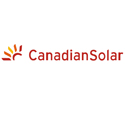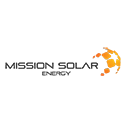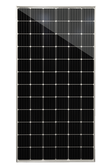 Loading... Please wait...
Loading... Please wait...Products
- DC Appliances
- Solar Refrigerators and Freezers
- Solar Panel Kits
- Solar Panels
- Solar Generators
- Inverters
- Inverter Monitoring
- Inverter Accessories
- Balance of Systems
- Racking and Mounting
- Rails
- Flashings
- Splice Kits
- Stopper Sleeves
- Conduit Mounts
- Attachments
- Brace Assembly
- Base Mount
- Brackets
- Bolts
- Clamps
- Caps
- L-Feet
- Washers
- Skirt
- Lugs
- Tilt Legs
- Hooks
- Stand-Offs
- Ballast Bay
- Top of Pole Mount
- Side of Pole Mount
- Flush Mount Kits
- Ground Mount Kits
- Roof Mount Kits
- Hardware Packages
- Wire Management
- Batteries
- Battery Accessories
- Charge Controllers
- Tools and Supplies
- View All Products
Solaris Blog - Panel Comparison
Canadian Solar vs Mission Solar: What’s Best?
Posted by Brandi Casey on 18th Dec 2019

Canadian Solar and Mission Solar are leading manufacturers of high efficiency, mid-range solar panels. Their solar modules are desirable for a variety of system types from residential to commercial, roof mount to ground mount and more. Canadian Solar, headquartered in Ontario, Canada has proven itself to be an industry leader in solar cell and module technology since its founding in 2001. While Mission Solar has quickly begun building brand recognition with their U.S. factory in San Antonio, Texas, where they design, engineer and assemble their solar modules.
Both Canadian Solar and Mission Solar offer a wide array of options in their solar panel offerings, including black on black designs, split cell technology, 60 cell, and 72 cell designs. Canadian Solar’s offerings also include bi-facial modules, bi-facial modules are recommended for ground mount applications, preferably installed on a reflective surface, to ensure that both sides of the module are getting ample sunlight in order to run more efficiently. In short, they are typically used in specific applications, if you have a site with the mentioned setup, you will want to see what Canadian Solar has to offer for you.
In terms of cost, both Canadian Solar and Mission Solar land in a mid-range price point, coming in between $0.10 - $0.20 more expensive than value-based modules such as those that can be purchased from Longi Solar. When compared to high value modules from manufacturers such as LG and Panasonic, the modules are between $0.20 - $0.35 less expensive on average.
In this Canadian Solar vs Mission Solar Panel Comparison, we will be explore the following:
- Specifications and Technology
- Average Costs and Efficiency
- Potential ROI
- Warranty and Degradation Rate
- And Solaris Recommendations
Specifications and Technology
Canadian Solar and Mission Solar both utilize Passivated Emitter Rear Contact (PERC) cell technology , which offers higher efficiency, and lowers the risk of hot spots developing. PERC works by utilizing the bottom layer of the cells to bounce sunlight back into the solar cell, which creates a dual capture process. This process enables the cells of your solar panel to capture more of the sun’s rays and generate electricity.
Where Canadian Solar differs from Mission Solar is largely seen in the solar module cell count. Canadian Solar's new lines largely utilize half-cut cell technology, which increases module efficiency and further decreases the chances of hot spots developing. The half cut cells work in the same manner as full cut cells, so a 144 half cut panel will be compatible with 72 cell module technology and 120 half cut cell panel is compatible with 60 cell module technology. To date, Mission Solar's modules are full cell 60 and 72 monocrystalline cell configurations.
Both Canadian and Mission's solar panels have high efficiency ratings for low irradiance environments, which further enhances the overall efficiency of your solar panel system. This increased efficiency is beneficial for both intermittent and frequent low light environmental conditions. So, no mater if you life in low light/temperature or high light/temperature, PERC cell technology is specifically designed to not only operate in the field, but do so with the upmost efficiency.
The table below reflects a number of available solar panels from Canadian Solar and Mission Solar, review Average Costs and Efficiency for a quick summary for comparison.
 |
Model Number | Max. Power | Efficiency | Cell Count | Technology | Information |
 |
CS3U-375-MB-AG |
375 Watts | 18.70% - 24.33% | 144 Half Cut (72) |
Monocrystalline Bifacial |
Pricing Specifications Warranty |
 |
CS1H-325MS |
325 Watts | 19.27% | 120 Half Cut (60) | Monocrystalline |
Pricing Specifications Warranty |
 |
CS1H-330MS |
330 Watts | 19.57% | 120 Half Cut (60) | Monocrystalline |
Pricing Specifications Warranty |
 |
CS3U-380MS |
380 Watts | 19.15% | 144 Half Cut (72) | Monocrystalline |
Pricing Specifications Warranty |

|
CS3K-320MS |
320 Watts | 19.26% | 120 Half Cut (60) | Monocrystalline |
Pricing Specifications Warranty |
 |
Model Number | Watts | Efficiency | Cell Count | Technology | Downloads |
 |
MSE310SQ8T |
310 Watts | 18.90% | 60 Cell | Monocrystalline |
Pricing Specifications Warranty |
 |
MSE375SQ9S |
375 Watts | 18.89% | 72 Cell | Monocrystalline |
Pricing Specifications Warranty |
 |
MSE60A310 |
310 Watts | 19.10% | 60 Cell | Monocrystalline |
Pricing Specifications Warranty |
The number of cells your solar panel has may affect the type of inverter you can use with the system. For example, most 60 cell and 120 half cell panels are compatible with the IQ7 from Enphase Energy, where as 72 and 144 half cut cell panels cannot be paired with the IQ7 and must use the IQ7PLUS. There are exceptions to this such as Canadian Solar's CS1H series which has a higher overall production rate that is not compatible with the Enphase IQ7.
For string inverter systems, the overall electrical output of your system will determine the inverter, and in some cases, the optimizer that will be best for your system. For assistance in sizing out your system and inverter, fill out our quote request form here.
Average Costs and Efficiency
In terms of price per watt averages, Canadian solar panels start at $0.68/watt, and Mission solar panels start at $0.71/watt. These price points come in around $0.05 - $0.10/watt more than value based panels from manufactures such as Longi and Trina Solar. When comparing the modules to high range panels, both Canadian Solar and Mission Solar average $0.20-$0.25/watt less expensive.
Canadian Solar's average efficiency rating is well above average, especially for a mid range panel. Their half cut cell design elevates the overall efficiency rating to rival high value panels like Panasonic and LG. Mission Solar's average efficiency is also above average when compared to other mid-range panels overall, but they fall behind Canadian Solar. This difference in efficiency may be made up in the expected degradation rate and output power of the manufacturers modules, we will cover this under Warranty and Degradation Rate.
| Manufacturer | Average Cost | Average Efficiency | Warranty |
| Canadian Solar | $0.68/watt | 19.56% | 10-yr Product | 25-yr Performance |
| Mission Solar | $0.71/watt | 18.96% |
12-yr Product | 25-yr Performance |
| Longi Solar | $0.69/watt | 18.58% | 10-yr Product | 25-yr Performance |
| Panasonic | $0.95/watt | 19.99% | 25-yr Product | 25-yr Performance |
*Average cost based on pricing as of the posting of this article.
See Here: How Much Does the Average DIY Solar System Cost?
Potential ROI
Next, let's take a look at the potential ROI for two similar systems from both Canadian Solar and Mission Solar. For the purposes of comparison, we will be composing a system of 20x 375w Mission Solar modules (7.5kW) and 20x 380w Canadian solar panels (7.6kW) both capable of generating approximately 10,800kWh per year, or 900kWh per month (the average kWh usage in the United States.
Both systems will be composed of the same composition roof mount system from IronRidge, in a 2x10 portrait configuration. Finally, we will be using the Enphase Energy IQ7PLUS microinverters, trunk cables, accessories and Envoy monitoring solution to complete the systems. Installation costs are not included in this DIY scenario, if you plan to use an outside installation company, be sure to account for their costs when generating your ROI estimation using the calculations below.
Canadian Solar |
Mission Solar |
|
| Solar Panels |
CS3U-380MS |
MSE375SQ9S |
| Microinverters |
Enphase IQ7-60-2-US |
Enphase IQ7-60-2-US |
| Accessories |
Trunk Cable Termination Caps Disconnect Tool |
Trunk Cable Termination Caps Disconnect Tool |
| Monitoring |
IQ+ Combiner with Envoy |
IQ+ Combiner with Envoy |
| Roof Mount Racking |
IronRidge Rails Splices Universal Module Clamps Stopper Sleeves Grounding Lugs Flashings Bonding Hardware Wire Clips End Caps Micro. Mounting Hardware Conduit Mounts |
IronRidge Rails Splices Universal Module Clamps Stopper Sleeves Grounding Lugs Flashings Bonding Hardware Wire Clips End Caps Micro. Mounting Hardware Conduit Mounts |
| Other |
Permit Plan Set Labels |
Permit Plan Set Labels |
| Sub Total | $10,503.54 | $10,445.34 |
| Est. Shipping | $370.00 | $360.00 |
| Avg. Total | $10,873.54 | $10,805.34 |
*Pricing calculated based on pricing as of the posting of this article.
The systems come in around the same price point with a little below $70 difference between the two. The Canadian Solar system comes to $10,873.54 while the Mission Solar system costs $10,805.34, when broken into price per watt, Canadian Solar comes in a bit lower at $1.43/watt and Mission solar at $1.45/watt including shipping and the permit plan set. These figures are based on pricing as of the posting of this blog and before possible solar energy tax rebates and incentives and does not include the cost of some balance of systems items, utility fees, installation costs and other project dependent expenses.
Both systems should be producing a little over 10,800kWh annually, and 900kWh per month. By taking the average cost per kilowatt hour in the United States (currently $0.12/kWh), we can determine the projected monthly savings of the system.
900kWh/month x $0.12kWh = $108 monthly savings
In order for the systems to pay for themselves, (excluding other factors such as installation costs, balance of systems items, rebates and incentives and so on). Canadian Solar's ROI period is 100.68 months or 8.39 years while Mission Solar's ROI period is 100.05 months also an average of 8.34 years.
As broken down above, the systems are very similar in overall costs, and, in some cases, they are nearly identical. Likewise, the efficiency rating of both panels is close, with only 0.26% difference separating them (Canadian Solar - 19.15%, Mission Solar - 18.89%).
*4.55kW Canadian Solar Roof Top System
Warranty and Degradation Rate
Canadian Solar offers a 10 year product warranty, Mission Solar's product warranty is 12 years. Both manufacturers provide 25 year linear performance warranties. Canadian's warranty is in keeping with average industry standards, however Mission Solar extends this warranty an additional two years, providing you with two more years of product warranty protection. Both the product warranty is outdone by manufacturers such as LG and Panasonic, both of which offer 25 year product and 25 year linear performance warranties.
At 80.7% output at the 25 year benchmark, Canadian Solar has a 0.5% higher expected output than Mission Solar (80.2%). Both panels degradation rate is highest during their first year of operation (Canadian Solar - 2.5%, Mission Solar - 3%), between the second and 25th year, both degradation rates falls to 0.7%.
See Here: Canadian Solar Warranty
See Here: Mission Solar Warranty
Solaris Recommendations
Both Canadian Solar and Mission Solar offer mid-range, high efficiency, long lasting solar panels. In terms of technological options, Canadian is a bit ahead of Mission, however Mission is a recently established manufacturer that has been quick to build both their technology and brand. For those seeking an American made solar panel, Mission Solar is an excellent option. The additional two year product warranty from Mission with the panels purchase is also helpful. However, both Canadian Solar and Mission Solar offer extended warranty periods that can be purchased from directly.
Canadian Solar's overall efficiency rate comes in higher than many of Mission Solar modules when compared on a watt to watt basis, additionally, their expected output is lower in the first year of ownership with higher expected output at the 25 year benchmark. They are an established manufacturer and are also an industry leader in solar cell technology. Their price point comes in a bit higher than Mission Solar, however the overall initial cost of purchase for both manufacturers is largely similar.
Your selection of panel may come down to any number of factors such as aesthetics, output, dimensions, snow load and so on. Both manufacturers offer technologically sound and durable solar panels, both are worth looking into for your next solar energy project.
See Here: Longi vs Trina Solar Panels: What's Best?
Products: Solar Panels for Sale




